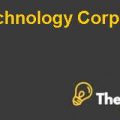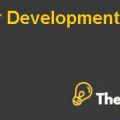
Question3.) What valuation method appears to be appropriate in this situation? Determine the value of OLC’s equity. Note that OLC currently has no debt.
However, there are a number of comparable company data is provided in exhibit 4 and 7, but not all the companies are similar to Oxford Learning Center in terms size and capital structure,such as Oxford Leaning Center is a 100 % equity finance and earns a limited amount of revenues in comparison to the comparable company data provided in the case. Therefore, considering the capital structure of Oxford Learning Center the most appropriate earnings multiplier would be EBITDA multiplier, because OLC is 100% equity financed and do not have any debt cost, meanwhile, it does not incur significant capital expenditure on a yearly basis. Hence, the selection of EBITDA measures the value of a company before considering interest expenses, depreciation expenses and any amortization expenses. Therefore, the most appropriate earnings multiplier would be EBITDA multiplier.
Further, the size of the organization and its capital structure also differ from the comparable companies, however, the most appropriate comparable company, whose data can be used in order to arrive at the appropriate value of Oxford Learning Center would be CorporateFamily Solutions. Because this company has no debt in issue and is 100% financed through equity which makes its capital structure similar to that of Oxford Learning Center.Meanwhile, although it has more number of franchise centers than OLC, but still it has franchised centers in double figures, whereas OLC has much lower numbers of franchise centers but it is closer to CorporateFamily Solutions than any other comparable company.Therefore, the most appropriate earnings multiplier that will give a reasonable valuation OLC would EBITDA multiplier of Corporate Family Solutions.
However, there are other valuation models that can be used in order to arrive at the more reasonable equity valuation of Oxford Learning Center such as the discounted cash flow valuation model. The discounted cash flow valuation model uses the estimated future cash flows during the life of a business and then discounts them using an appropriate risk adjusted discount rate. Further, since OLC is expecting huge demand in the future and the same has been projected in the forecasted income statement, therefore, discounted cash flow valuation model will give a more realistic value of OLC.
Question4.) As Whitehead, at what price would you agree to sell to Harold Lewis?
Using the EBITDA multiple of CorporateFamily Solutions the estimated price per share of the OLC has been calculated at $1,338,068. Meanwhile, in order to calculate the equity value of OLC through discounted cash flow technique, the forecasted income statement of OLC over the next five have been used. However, since the income statement has charged the tax on EBITDA, which means, OLC has no depreciation or capital expenditure that needs to be incorporated into the discounted cash flow calculation. However, the incremental working capital has been calculated using the historical working capital requirement as a percentage of sales revenue. Additionally, the projected income statement has been prepared for the next five years only, but in order to calculate the valuation of OLC through discounted cash flows, we need to incorporate the cash flows for the entire of the business. Therefore, terminal values have been calculated, in order to include the effect of cash flows after year five and a growth rate of 3.5% has been assumed for the calculation of terminal values.
Further, since OLC is 100% equity financed, therefore, the cost of equity has been used in order to discount the net cash flows. Meanwhile, the average of competitors’ un-geared beta of 0.587 has been used, because OLC has no debt, hence, there is no need to re-gear the asset beta. Moreover, the interest rate of 4.57% on 1-month Canadian government Treasury bills has been used as the risk free ratefor the calculation of cost of equity for OLC. Hence, the cost of equity for the valuation of the OLC has been calculated at 9.01%. Additionally, the terminal values after the year2002 has been calculated using the last year’s cash flows, cost of equity and the growth rate for terminal values, which gives a value of $18,201,958/-. However, the net cash flows over the five year period and the terminal value have been discounted using the cost equity as calculated above, which gives a net present value of $14,185,029/-, meanwhile, each share of OLC would be valued at $1,418,503/-...............................
This is just a sample partial case solution. Please place the order on the website to order your own originally done case solution.












